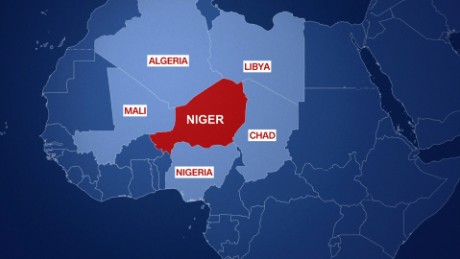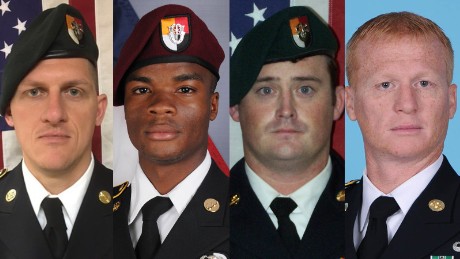Niamey, Niger (CNN)Outnumbered and lightly armed, a Green Beret-led team that was ambushed by militants in Niger earlier this month became separated during the firefight, US officials and a Nigerien soldier told CNN Thursday.
The squad was traveling with 30 Nigerien soldiers when they were attacked by approximately 50 ISIS-affiliated fighters armed with rocket propelled grenades, mortars, and heavy machine guns, according to US military officials.
During the subsequent gun battle, which lasted for hours, four US soldiers were killed and two were wounded. Five Nigerien soldiers were also killed. US-Nigerien forces managed to kill 20 militants during the fight on October 4.
When the unit of the Nigerien soldier who spoke to CNN arrived on the scene, the surviving US and Nigerien troops were standing back to back, trying to cover all sides in a defensive position. The brush around them was smoldering, the result of fires lit by militants to prevent aircraft from coming to their rescue.
"I admired their bravery, they were ready to fight until the end," said the soldier, who was not authorized to speak publicly.
By then the fight had been going on for some time. The team initially requested back up one hour after the ambush began. A US drone arrived within minutes of their call for help, but it was unarmed because US drones in Niger are not authorized to be armed, a US defense official told CNN.
The Nigerien soldier said he was told by wounded Nigerien troops that the first two vehicles had been hit by militants and subsequently split from the convoy. A US official directly familiar with after action reports also told CNN the convoy had been separated during the attack.
It took another hour before armed French Mirage jets arrived -- two hours after troops made initial contact with enemy forces.
The four US soldiers killed during the ambush were all in the same part of the separated convoy, according to two US defense officials.
French military helicopters and contractor aircraft landed to evacuate the wounded US and Nigerien troops, and then later returned for the bodies of the dead.
The body of one American soldier, Sgt. La David Johnson, would not be recovered for another 48 hours.
Nigerien soldier: US troops weren't prepared
The Nigerien soldier who spoke to CNN suggested that the joint US-Nigerien unit may have been insufficiently armed and unprepared for a patrol into what he described as a high-risk area.
The soldier said he first encountered the 12-member US team on October 3 -- the day before the ambush -- when they were on the way to their objective, an abandoned encampment that had previously been the location of a regional terrorist leader, codenamed "Naylor Road."
At the time, the US troops had only one heavy machine gun, no body armor and were driving unarmored 4x4s while wearing "t-shirts and baseball caps," the Nigerien soldier said.
"I was surprised that the Americans would go out into the zone with such a light convoy and no air cover, no drones to keep watch over them," the soldier said.
The Pentagon could not say Thursday whether the US troops were wearing body armor at the time of the attack.
Multiple US military officials had told CNN previously that the American soldiers were driving unarmored pick-up trucks and it is not uncommon for Green Beret-led military advisers to not wear body armor when accompanying host nation forces in low-threat areas. The officials told CNN that the team was never expected to encounter hostile forces during its patrol and intelligence gathering operations.
Joint Staff Director Lt. Gen. Kenneth McKenzie said Thursday that dozens of similar patrols in that same general area over the course of the last six months had not encountered any enemy forces, and that "it was the judgment of the commanders on the ground that that probability was unlikely."
How the ambush happened
The 12-man Green Beret-led team was given several different tasks before it was ambushed on October 4, but its primary mission was to advise and assist a unit of 30 Nigerien soldiers.
That mission did not change, but in the lead-up to the attack, the team was given a new task -- to assist the Nigerien soldiers in support of a separate US-Nigerien team that was planning to capture or kill the targeted terrorist leader in Niger, three US officials told CNN on Wednesday.
But before the capture-or-kill operation was launched, US intelligence assets observed the target abandon his encampment in Niger and cross the border into Mali.
The mission was then canceled, and the team advising the support units was assigned to visit the abandoned encampment to collect intelligence on the suspect. They did not encounter any enemy forces at the site and left the location.
On their way back to base, they stopped in a separate village in order to enable the Nigerien troops to replenish supplies. While there, US troops met with local leaders as a courtesy.
The US officials said it was "quite probable" that someone in the village tipped off the ISIS-affiliated terrorists that US forces were in the village, setting up the ambush.
On Friday, two regionally-based intelligence sources told CNN that the recent pattern of terror attacks in west Africa suggested that US-Nigerien forces were more likely a target of opportunity rather than a pre-planned operation, adding that the troops were "very unlucky" in that case.
After the ambush, the Nigerien soldier said his unit and another Nigerien unit spent the night of October 4 securing the location, with more helicopters arriving, along with US troops equipped with night vision who searched on foot for Johnson. It wasn't until the following afternoon that a local village chief told officials he had seen a body.
The bodies of three of the fallen soldiers -- excluding Johnson -- were recovered by a separate team of US military personnel, according to a US defense official. Those personnel were part of the original canceled high-value target capture-and-kill team, which the day before the ambush was going after the terrorist leader codenamed Naylor Road.
McKenzie acknowledged the existence of the second team during Thursday's Pentagon news briefing.
Johnson's body was finally recovered 48 hours after the attack, nearly a mile away from the scene, four administration officials familiar with the early assessment of what happened told CNN last week.
Fallout over the ambush
The episode has raised serious concerns in Washington about the readiness of US troops in Niger and questions about the role of US troops in the country.
Senior military commanders have said that the investigation will take time and that its findings will first be shared with the families of the fallen.
"The very first people that we want to sit down with and share the facts are the families, once the investigation is complete," Joint Chiefs Chairman Gen. Joseph Dunford told reporters Tuesday.
A defense official told CNN on Tuesday that the chief of staff to the commander of US Africa Command, Major Gen. Roger Cloutier Jr., is leading the formal investigation into the deadly ambush.
The Chairman of the Senate Armed Services Committee, Sen. John McCain, who was briefed Thursday by defense officials on the incident, told reporters the investigation may take 30 days to complete.
Other Senators questioned whether the role of US troops in Niger needed to be re-examined in the wake of the attack.
The Nigerien soldier who spoke to CNN suggested that the US had failed to effectively combat the security challenges in Niger.
"The main question we are asking ourselves is that if Americans are dying here, when are they going to realize that their efforts aren't generating results?" he asked. "They need to change tactics, they need to give more support."










